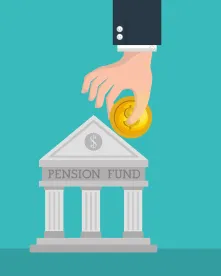We had pondered when this day would come. The doomsday scenario that the Pension Benefit Guaranty Corporation (PBGC) would become insolvent in five to six years is now old history. (The new estimated time of PBGC insolvency is the mid-2040s.) Plan participants, the plans, employers, unions, and the PBGC had all been patiently waiting for relief—and they have apparently been rewarded with the relief they were seeking.
The American Rescue Plan Act of 2021, signed by President Joe Biden on March 11, 2021, included the Butch Lewis Emergency Pension Plan Relief Act of 2021 (Pension Relief Act), which will provide special financial assistance, in a single lump-sum payment, to certain underfunded multiemployer defined benefit pension plans. The payment will, in theory, pay for all accrued benefits owed to retirees, without reduction, through the plan year ending in 2051, without any obligation to repay such funds. The Congressional Budget Office (CBO) has estimated that the cost of this special financial assistance will exceed $86 billion, although such cost is not capped in the Pension Relief Act.
While we have the statutory language, which we describe below, the details are still fuzzy. The PBGC is tasked with issuing interpretive regulations or guidance within 120 days of the date of the Pension Relief Act’s enactment. As they say, the devil is in the details, so stay tuned.
Relief for Multiemployer Pension Plans Generally
The Pension Relief Act contains provisions that more generally affect multiemployer defined benefit pension plans—regardless of funding status.
Temporary Delay of Funding Zone Designation
A plan can elect to use the same funding zone status that applied in the prior plan year for either (or both) of the first two plan years beginning on or after March 1, 2020, regardless of its actual funding situation. Once this election has been made, however, it cannot be revoked without consent from the U.S. Department of the Treasury. This election is not available if a plan is certified as being in critical status in the plan year beginning on or after March 1, 2020.
Temporary Extension of Funding Improvement and Rehabilitation Plans
For plans in endangered or critical status, trustees are required to review and update the funding improvement plan or rehabilitation plan, as applicable, each year. The Pension Relief Act suspends this annual review requirement for the first two plan years beginning on or after March 1, 2020. Moreover, such plans in endangered or critical status can elect to have the funding improvement or rehabilitation period extended by five years (for critical plans, from a 10-year period to a 15-year period; for seriously endangered plans, from a 15-year period to a 20-year period).
Adjustments to Amortization of Experience Losses
The Pension Relief Act permits plans meeting solvency requirements as of February 29, 2020, to minimize the impact of experience losses (including investment losses and other COVID-19–related losses) by amortizing these losses for the first 2 plan years ending after February 29, 2020, over 30 years instead of 15 years in the plan’s funding standard account. Such plans may also change their asset valuation methods to smooth the difference between expected and actual investment returns for either or both of the first 2 plan years ending after February 29, 2020, over a period of up to 10 years (instead of 5 years) when determining actuarial value of assets, so long as the value of plan assets is not less than 80 percent or more than 130 percent of the fair market value of the assets. Note that such amortization of experience losses is not available to plans that receive special financial assistance (described below).
Special Financial Assistance for Severely Underfunded Multiemployer Pension Plans
The Pension Relief Act creates a separate fund within PBGC to provide special financial assistance in amounts that the U.S. Department of the Treasury and the PBGC deem necessary.
Eligibility
A multiemployer pension plan is eligible to receive special financial assistance if it meets one of four conditions:
-
the plan is in critical and declining status for a plan year beginning in 2020 through 2022;
-
the plan has an approved benefit suspension under the Multiemployer Pension Reform Act of 2014 (MPRA) as of the date the Pension Relief Act is enacted;
-
the plan is in critical status in any plan year beginning in 2020 through 2022, is under 40 percent funded on a current liability basis, and “has a ratio of active to inactive participants which is less than 2 to 3”; or
-
the plan became insolvent after December 16, 2014, and has remained insolvent—but not terminated—as of the date the Pension Relief Act was enacted.
The Pension Relief Act provides that for the first two years after enactment, applications for special financial assistance may be filed only by the following:
-
plans that are insolvent or likely to become insolvent within five years of the date of enactment of the Pension Relief Act;
-
plans that have a present value financial assistance that exceeds $1 billion if special financial assistance is not provided;
-
plans that received approval under MPRA to suspend benefits; or
-
plans as otherwise determined by the PBGC.
Amount of Special Financial Assistance
Once determined eligible by the PBGC through a formal application process that will not start until the PBGC has issued regulations, a plan is entitled to receive the special financial assistance in the form of a single lump-sum payment. The amount of the special financial assistance will be equal to the amount necessary for the plan to pay for all accrued benefits owed to retirees, without reduction, from the date of the payment of the special financial assistance until the last day of the plan year ending in 2051, as determined based on prescribed actuarial assumptions.
Conditions on Receiving Special Financial Assistance
The Pension Relief Act requires a plan receiving special financial assistance to reinstate benefits that were suspended on a go-forward basis and retroactively. The special financial assistance must be segregated from other plan assets and invested in investment-grade bonds or investments otherwise permitted by the PBGC. The Pension Relief Act also specifically contemplates that the PBGC might issue restrictions to plans receiving special financial assistance with respect to “increases in future accrual rates and any retroactive benefit improvements, allocation of plan assets, reductions in employer contribution rates, diversion of contributions to, and allocation of expenses to, other benefit plans, and withdrawal liability.” A plan receiving special financial assistance may or may not pay benefits and administrative expenses from the special financial assistance account so established that could impact the financial status of the plan’s traditional financial account. The consequences of a plan’s making that decision may affect the plan’s funding improvement and rehabilitation plans and withdrawal liability.
Impact on Contributing Employers
Analysis of the impact of the Pension Relief Act on contributing employers is murky without the benefit of implementation guidance from the PBGC. Below are some initial insights based on the statutory text, but much remains to be determined until the PBGC exercises the regulatory discretion afforded it under the Pension Relief Act.
-
Employer Contributions
The Pension Relief Act does not address employer contributions, except to state that the PBGC can issue regulations that restrict plans that receive special financial assistance from reducing future employer contributions. A plan that receives special financial assistance “shall be deemed to be in critical status … [until] the last plan year ending in 2051,” so it seems that the plan’s rehabilitation plan—and any mandated future employer contribution increases—would likely remain in effect.
-
Withdrawal Liability
The funding status of a pension plan is a major factor in determining assessable withdrawal liability. Yet the Pension Relief Act may not provide any relief to exiting employers regarding withdrawal liability—at least not in the near future. Earlier drafts of the Pension Relief Act had included an explicit provision that any special financial assistance received by a plan was to be disregarded, for purposes of withdrawal liability calculations, for the 15 years following the receipt of the special financial assistance. This provision, however, was struck from the version of the Pension Relief Act that was passed by the U.S. Senate and ultimately enacted. There is speculation, however, that special financial assistance might be disregarded for the purposes of withdrawal liability calculations for 10 years, similar to the principles contained in § 4233(d)(3) of the Employee Retirement Income Security Act. (This provision was enacted as part of MPRA for partitions and may inform the PBGC in this regard.) Pending further guidance and regulations, it remains to be seen whether special financial assistance will be disregarded for the purposes of withdrawal liability calculations for a certain period of time. Notably, the Pension Relief Act did not address the calculation methodology for withdrawal liability, such as the maximum annual payment or 20-year cap rules, but given the broad regulatory authority granted to the PBGC, it is possible that these rules could be modified.
-
PBGC Premiums Paid by Multiemployer Pension Plans
Regardless of whether a plan received special financial assistance, the PBGC flat-rate premium for all multiemployer pension plans will increase for plan years beginning in 2031. The current PBGC flat-rate premium for 2021 is $31 per individual and is indexed—but the CBO projected that the indexed amount without any increase would have been $44 per individual for 2031.
After years of failed attempts to address the multiemployer pension funding crisis, the Pension Relief Act comes as a shock to some and welcome relief to others. Contributing employers may want to carefully consider how to manage their participation in multiemployer plans in light of the Pension Relief Act and further regulations to be issued.





 />i
/>i

